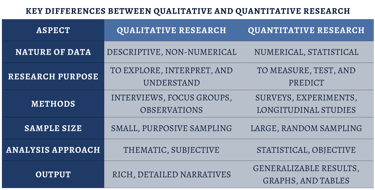Save $400 on your edit with the Preferred Client Value Package! Hurry—space is limited!
Understanding the Differences Between Qualitative and Quantitative Research
4 min read


When embarking on a research project, one of the first decisions you will face is choosing between qualitative and quantitative research methods. Each approach serves distinct purposes and yields different data types, so understanding the key differences is essential for selecting the method that best aligns with your research objectives. Both methods are valuable tools in academic and professional settings. This article will explore the fundamental differences between qualitative and quantitative research, their applications, advantages, limitations, and when to consider using a mixed-methods approach.
What is Qualitative Research?
Qualitative research focuses on exploring and understanding participants' meanings, experiences, and perspectives. It is typically used when the goal is to gain in-depth insights into complex phenomena rather than producing numerical data. This method seeks to interpret human behaviors, social contexts, and the "why" behind specific actions or thoughts.
Key Features of Qualitative Research
Data Type: Non-numerical, descriptive data (e.g., words, images, observations).
Methods: Interviews, focus groups, participant observation, ethnographic studies, and content analysis.
Purpose: To explore underlying motivations, emotions, and behaviors.
Sample Size: Often small, selected purposefully to provide detailed insights.
Analysis: Interpretative and subjective, focusing on themes and patterns.
Output: Rich narratives that provide context and depth to the subject.
Examples of Qualitative Research Questions
"How do college students experience the transition to online learning?"
"What are healthcare workers' perceptions about workplace support during a pandemic?"
"What factors contribute to a sense of belonging in community spaces?"
What is Quantitative Research?
Quantitative research centers on collecting and analyzing numerical data to test hypotheses, measure variables, and identify patterns. It is ideal for studies that establish relationships, make predictions, or generalize findings to larger populations. This method provides measurable results that are easy to replicate and compare.
Key Features of Quantitative Research
Data Type: Numerical data (e.g., statistics, percentages, frequencies).
Methods: Surveys, experiments, structured observations, longitudinal studies, and secondary data analysis.
Purpose: To quantify variables and test relationships or hypotheses.
Sample Size: Larger, often randomly selected for generalizability.
Analysis: Statistical and objective, using software like SPSS, R, or Python.
Output: Charts, graphs, and tables that summarize numerical findings.
Examples of Quantitative Research Questions
"What is the relationship between study habits and academic performance among high school students?"
"How does the implementation of a new policy affect employee productivity levels?"
"What percentage of individuals prefer telemedicine over in-person consultations?"


When to Use Qualitative Research
Choose qualitative research when:
You want to explore complex phenomena in detail.
You aim to understand participant perspectives and lived experiences.
The topic is relatively new, and little prior research exists.
Flexibility in research design is necessary.
You need to uncover motivations, attitudes, or social dynamics that cannot be quantified.
Advantages of Qualitative Research
Provides rich, in-depth insights.
Captures the complexity of human experiences.
Allows for adaptability during the research process.
Encourages exploration of topics in an open-ended manner.
Limitations of Qualitative Research
Time-consuming and resource-intensive.
Findings may not be generalizable to a larger population.
Subjectivity can lead to potential researcher bias.
Interpretation can vary based on the researcher’s perspective.
When to Use Quantitative Research
Choose quantitative research when:
You want to test specific hypotheses or theories.
Your goal is to establish relationships between variables.
Generalizability and replicability are priorities.
Large-scale data collection is feasible.
Numerical precision and statistical validity are required.
Advantages of Quantitative Research
Produces objective and replicable results.
Allows for generalizations to larger populations.
Efficient for analyzing large datasets.
Results can be presented using statistical visuals.
Limitations of Quantitative Research
Limited ability to explore nuanced experiences or motivations.
Relies on predefined variables and structured tools.
May overlook contextual or cultural factors.
Often requires significant preparation and statistical expertise.
Mixed-Methods: Combining Qualitative and Quantitative Methods
For many research projects, combining qualitative and quantitative methods provides a more comprehensive understanding of the research problem. This mixed-methods approach leverages the strengths of both methods while mitigating their weaknesses. It is especially useful in multidisciplinary studies or projects addressing complex societal issues.
Benefits of a Mixed-Methods Approach
Offers both breadth and depth of understanding.
Enables triangulation of findings to enhance validity.
Provides richer insights by integrating diverse data sources.
Helps to validate and contextualize quantitative results with qualitative data.
Example of a Mixed-Methods Study
Quantitative Component: Surveying 500 participants to measure satisfaction levels.
Qualitative Component: Conducting in-depth interviews with 20 participants to explore underlying reasons for their satisfaction.
Integration: Analyzing how quantitative trends align with qualitative themes to form a complete picture.
Final Thoughts
Understanding the differences between qualitative and quantitative research is crucial for selecting the right method for your study. While qualitative research delves into the richness of human experience, quantitative research provides the precision and generalizability needed to test theories and hypotheses. Both approaches have unique strengths and limitations; the choice ultimately depends on your research objectives.
In some cases, the most robust approach combines both methods to leverage their complementary strengths. This ensures a more holistic view of the research topic and provides deep and broad insights.
If you need support designing your research methodology, we offer professional editing services to help you refine your study. Whether you’re conducting qualitative, quantitative, or mixed-methods research, we’re here to assist you.
Ready for a FREE Estimate?
Contact us today to discuss your project and get a personalized quote. We’re here to help you succeed!
Professional editing services for dissertations and theses.
© 2025 Preferred Edits LLC. All rights reserved.
